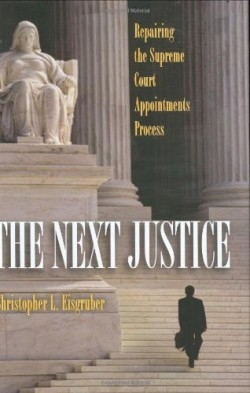The Next Justice
Repairing the Supreme Court Appointments Process
Hot lights and dozens of cameras point at a Supreme Court nominee seated behind a long table. Sharp questions crackle from Senators on the Judiciary Committee and the candidates bob and weave like prize fighters. According to Eisgruber, the process by which the United States confirms justices to its highest court is broken. Since major constitutional questions are on the court’s agenda, such as equal protection, free speech, abortion rights, and privacy rights, changes must be made before the next nomination.
Eisgruber, author of Constructional Self-Government and co-author of Religious Freedom and the Constitution, is a graduate of Princeton University and provost and professor of Public Affairs there. He clerked for Supreme Court Justice John Paul Stevens and US Court of Appeals Judge Patrick Higginbotham.
The author traces the problem back to President Richard M. Nixon’s tendency to nominate justices who shared his ultra-conservative outlook such as Warren Burger, Clement Haynesworth, Harold Carswell, and William Rehnquist. He only sought more moderate candidates, like Harry Blackmun, when forced to by Senate rejection. Most presidents have followed his example, causing the appointment process to become both more rancorous and less revealing about the type of justice a nominee will become.
History pivots on the process. The outcome of Bush v. Gore, where the five-to-four decision stopped a recount of the votes in Florida for the 2000 presidential election, effectively put George W. Bush in office. “Ordinarily, the Court’s conservatives are skeptical about novel equal protection clause claims and friendly to the states. Conversely, the court’s liberals are more willing to entertain new claims…In Bush v. Gore, their roles were reversed,” Eisgruber writes. Since the outcome fit perfectly with the supposed preferred candidate of the majority of justices, many voters were disturbed by the decision.
Change can begin with an acknowledgement that Senators already know the political leanings of a nominee and must therefore judge them on open discussions of their judicial philosophy. The determining factor in the process must be their answers to questions on the Court’s role; their view of the constitution as a living document or a static canon; whether deference must be shown to lawmakers; their outlook on judicial review as a democratic tenant; their view on rights like travel, parental rights, and privacy not specifically mentioned in the constitution; and their credentials as moderate jurists. Evasive nominees must be rejected. Eisgruber’s analysis is essential reading for both lawmakers and the public.
Reviewed by
Deirdre Sinnott
Disclosure: This article is not an endorsement, but a review. The publisher of this book provided free copies of the book to have their book reviewed by a professional reviewer. No fee was paid by the publisher for this review. Foreword Reviews only recommends books that we love. Foreword Magazine, Inc. is disclosing this in accordance with the Federal Trade Commission’s 16 CFR, Part 255.

